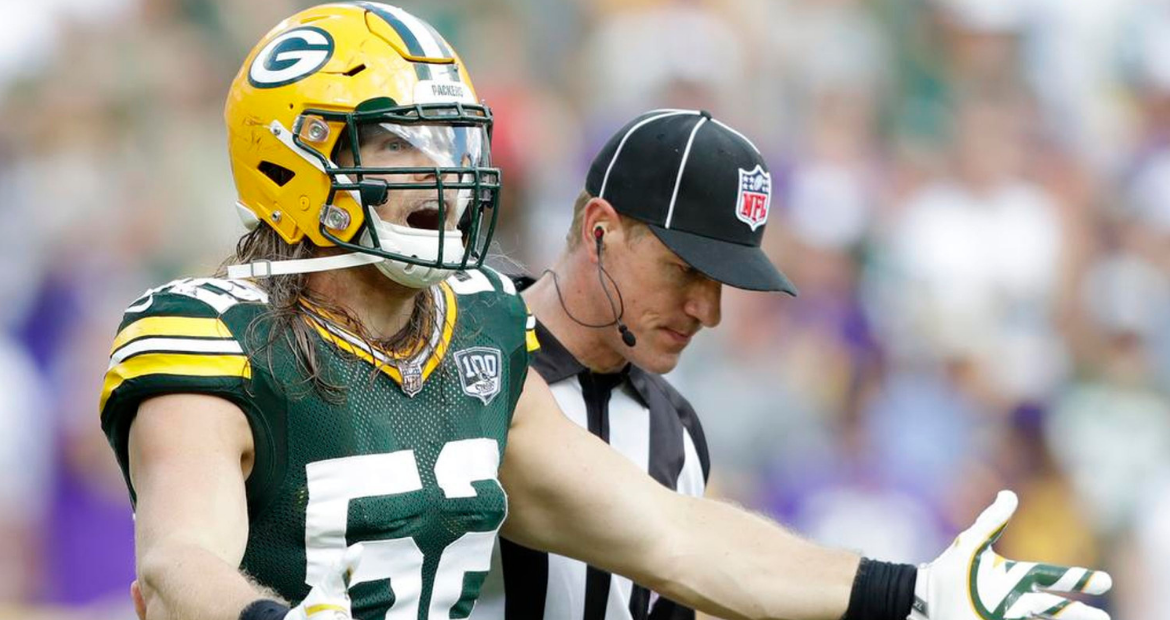
Roughing the Passer: The Penalty That is Changing Football
Less than two minutes were on the clock, and the Packers were up 8 points on the visiting Vikings in Week 2. Minnesota was on their own 25-yard line when Kirk Cousins threw downfield, and Packers rookie corner Jaire Alexander caught the ball for what looked like the game-ending interception – except Clay Matthews broke through the Vikings defensive line and hit Cousins just as the ball was released. The contact looked textbook. Matthews took Cousins to the ground but caught himself as not to put his full body weight on the QB. Still, a flag was thrown, roughing the passer. The interception was negated, and Minnesota and Green Bay went on to tie.
Matthews expressed his frustration, “You see how it changed the game. I know there’s an emphasis on protecting quarterbacks, but it’s gotten out of control. I don’t know what else to do. It’s frustrating because Jaire’s interception, that’s game [over], right? Instead, they go down and score, overtime, this and that.”
The NFL doubled down and said the call was correct. Referee Tony Corrente curiously explained his call to ESPN after the game.
Referee Tony Corrente told pool reporter @RobDemovsky that Matthews was flagged because, “when he hit the quarterback, he lifted him and drove him into the ground.” Was not the new NFL rule about body weight on the QB. Watching this replay … I don’t see it. https://t.co/8iYOGLe57J
— Jason Wilde (@jasonjwilde) September 16, 2018
The murkiness of the roughing the passer penalties this year has been frustrating because it defies physics and feels a long way from the football we grew up watching, but also because of its sheer frequency.
In the first four weeks of the NFL last year, there were 21 roughing the passer penalties. This year we’ve seen 38 penalties called, an 81 percent increase in calls.
More than that, calls like the one in Green Bay clearly impact the outcome of the game, but the penalties might be changing more than just the results.
In Week 2 against Green Bay, Cousins threw for 425 yards. The last time he threw for more than 400 yards in a single game was November of 2016. Cousins put up another 400+ yard game in the Vikings’ Week 4 loss to the Rams.
Cousins isn’t alone. Quarterbacks have thrown for at least 400 yards in a game on 12 different occasions, the most in NFL history through the first four weeks of a season. In Week 4, we saw five 400-yard passing performances, the most in a single week in league history.
According to ESPN’s Adam Schefter, NFL teams have scored 3,030 points which is the most through Week 4 in NFL history. Similarly, this year we’ve seen the most touchdowns (344) scored and the most touchdown passes (228) through the first quarter of a season in NFL history.
Some numbers from first quarter of the NFL season:
*3,030 points scored is most through Week 4 in NFL history (2,986, 2012)
*344 touchdowns are most through Week 4 in NFL history (332, 2015)
*228 touchdown passes are most through Week 4 in NFL history (205, 2013).
— Adam Schefter (@AdamSchefter) October 2, 2018
It’s also worth noting the NFL TV ratings are up .7 percent through the first three weeks of the season according to Nielsen. There could be many reasons why, and one of those reasons may be the exciting offenses we’ve seen so far this season. When QBs are getting more leeway and putting up explosive numbers, and the league is installing rules to raise the chances that Tom Brady, Aaron Rodgers and Drew Brees take the field each week, more people are going to watch. In fact, in Week 3 the Lions-Patriots game scored an overnight rating of 13.6 — the best for NBC’s “Sunday Night Football” since 2015.
The numbers are telling. The offensive boom is real this season. Four weeks in it’s hard to say without a doubt that roughing the passer penalties are the only thing aiding offenses in the NFL. More points and touchdowns have come from more talented quarterbacks and/or exotic scheming, but to deny that QBs are getting more time to make decisions, likely because of roughing the passer calls, is ignoring what the penalties are doing to the game.
Historically when a new rule or different enforcement of a rule is implemented, the calls come fast and fiercely at the start and then the refs and players begin to settle in. It hasn’t happened like that for the roughing the passer penalties. In Week 1, 15 flags were thrown. In Week 2, we saw six. Week 3 the calls were back up to 12, and finally, in Week 4, we saw five roughing the passer penalties. At the current rate, the NFL is on track to see 152 penalties throughout the 2018 season, 46 more than the 106 we saw in 2017.
NFL Network reported after Week 3 that some competition committee members were not happy with the way the rule was being applied, but when the committee met to look at footage of calls, they stood by their position. The NFL’s executive vice president of football operations, Troy Vincent said the committee ultimately “determined there would be no changes to the point of emphasis approved this spring or to the rule.”
Statement from @NFL Executive Vice President of Football Operations @TroyVincent23
Video – contact on the QB https://t.co/IiR8sfBkq7 pic.twitter.com/9Xt5f5Arwi
— Michael Signora (@NFLfootballinfo) September 27, 2018
In a conflicting report, NFL Network’s Ian Rapport revealed the competition committee wants to see fewer calls noting, “The message to officials was you have to be absolutely sure the body weight of a defender lands on the quarterback. If you’re not sure, just wait and let the league fine a player on Monday.”
Rapport also reported the committee is in agreement that the week 2 hit on Kirk Cousins was not a foul.
The NFL’s Competition Committee conference call this week yielded two conclusions: There are expected to be fewer roughing the passer penalties and #Packers LB Clay Matthews’ hit on Kirk Cousins was not thought to be a foul. My story for @NFLGameDay: https://t.co/WjaVYNT4Lx
— Ian Rapoport (@RapSheet) September 30, 2018
Four weeks is not enough time to know the lasting impact of the rule, but if the numbers continue to follow the trend we’re in for a lot more high-scoring showdowns and a score of disgruntled fans and defensive players.



